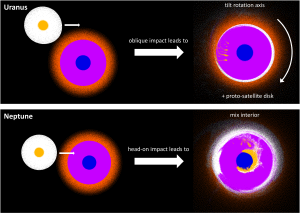Blog
Striking Differences
8 February 2020
 NASA/JPL
NASA/JPLThe planets Uranus and Neptune are similar in many ways. Both are icy gas planets. They have similar mass and composition. But the sister worlds are also quite different. Neptune has a warm core that radiates heat into the planet’s atmosphere, while Uranus does not. Uranus has a collection of moons that likely formed from a ring of debris, while the moons of Neptune were likely captured. Why are these differences so striking?
Uranus is perhaps the stranger of the two. Its axis is tilted about 98 degrees from its orbital plane, making it a planet on its side. This is a strong indication that a large body collided with Uranus in its early history. So perhaps it was this collision that made the world so different from Neptune.
 Reinhardt & Helled, ICS, University of Zürich
Reinhardt & Helled, ICS, University of ZürichRecently a team looked at this idea.1 While earlier studies have modeled collisions with Uranus, this work looked at collisions with both Uranus and Neptune. Surprisingly, they found that both planets have had major collisions. After modeling various collision scenarios, the team found that Uranus likely had a more glancing collision with a large body. This would create a disk of debris out of which moons could form, but would leave the core of Uranus largely intact. On the other hand, Neptune likely suffered a head-on collision. This would not produce a debris disk but would mix the interior of Neptune, making it geologically active.
Planetary collisions were quite common in the early solar system, so it is not surprising that both worlds experienced collisions. What is surprising is how small differences in their collisions have led to such a striking difference in their appearances today.
Reinhardt, Christian, et al. “Bifurcation in the history of Uranus and Neptune: the role of giant impacts.” Monthly Notices of the Royal Astronomical Society (2019). ↩︎